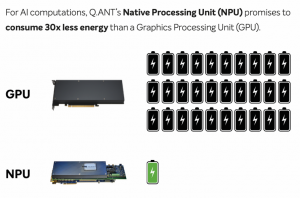Photonic computing is not high on the list of hyperscalers or HPC users. The method is new, and if it continues to improve, it may shake up the entire HPC and AI industry. Debuting last year at ISC 2024, Q.ANT (pronounced “quant”) showed the beginnings of a Photonic computing system. This year, ISC attendees were able to experience the analog photonic device computing on the show floor.
Q.ANT is a relatively new company pioneering photonic computing. Founded in 2018, Q.ANT develops processors that compute natively with light, delivering scalable, energy-efficient performance for next-generation AI and HPC applications. The company operates a dedicated photonic chip pilot line in Stuttgart, Germany.
During ISC 2025, Q.ANT provided live demonstrations of its photonic Native Processing Server (NPS). Built on Q.ANT’s Light Empowered Native Arithmetic (LENA) architecture, the NPS promises to deliver up to 30 times the energy efficiency of conventional technologies and may set new performance benchmarks and functionality milestones for AI in HPC systems, including:
- 16-bit floating point precision with 99.7% accuracy for all computational operations on the chip
- 40–50% fewer operations required for equivalent output
- No active cooling infrastructure is required, saving cost and energy
The Q.ANT system’s core is a proprietary, thin-film lithium niobate (TFLN) photonic chip that directly executes complex, nonlinear mathematical operations in the optical domain. This computing breakthrough will enable high-speed, low-loss optical modulation without thermal crosstalk, reducing energy-intensive cooling and allowing up to 100x greater compute density per rack in a data center framework while achieving up to 90x lower power consumption per application.
“Q.ANT is attacking two of the biggest challenges in photonic computing: integration and precision –while addressing the promise of computational and energy efficiency,” said Bob Sorensen, Senior VP for Research and Chief Analyst for Quantum Computing at Hyperion Research. “Q.ANT is offering an innovative alternative to digital processors with an analog counterpart that can excel at nonlinear and mathematical operations, particularly in AI inference operations, physics simulations, and image analysis, all while demonstrating 99.7% accuracy on the photonic chip across complex computational tasks—proving that analog computing can be accurate, performant and deployable.”
Q.ANT’s photonic architecture is designed to complement existing computing models. Its analog processors excel at nonlinear and mathematical operations that digital systems struggle with, particularly in AI inference operations, physics simulations, and image analysis. Q.ANT has started to ship its Native Processing Server (NPS) to selected partners.
Ready for the rack
Q.ANT is offering the first photonic 19 “Rack-mountable server, called the Native Processing Server NPS. It has a Photonic AI Accelerator as a PCIe card designed specifically for AI inference and advanced data processing and requires a mere 45 Watts of power. The NPS employs a 4U Linux-based x86 server as the host that can be easily integrated into data centers and HPC systems to provide immediate access to photonic computing. The system can be upgraded with additional PCIe cards for even more processing power.
 Q.ANT Native Processing Server (NPS) is a 4U Linux-based x86 server (left) hosting a Photonic AI Accelerator as a PCIe card (right) Source: Q.ANT
Q.ANT Native Processing Server (NPS) is a 4U Linux-based x86 server (left) hosting a Photonic AI Accelerator as a PCIe card (right) Source: Q.ANT
The Q.ANT toolkit
The Q.ANT Native Processing Server features an interface known as the Q.ANT Toolkit. This interface enables users to operate directly at the multiplication level or leverage optimized neural network operations, such as fully connected or convolutional layers. The Toolkit offers a comprehensive collection of example applications that illustrate how AI applications can be enhanced. These examples can be used directly or as a foundation for creating their own implementations.
For example, the following types of applications are supported in a well-known Python or C++ environment.
- Multiplication of a matrix and a vector can be done using Python / C++
- Classification of images (e.g., based on ImageNet data set) can be performed using Python (Jupyter)
- Segmentation of images (e.g., based on brain MRI scan data set) can be done in Python (Jupyter)
- Attention-based AI models, e.g., speech recognition, are built using Python (Jupyter)
The promise of photonic computing
Progress in phonetic computing has been bolstered by the speed at which it can deliver lower precision operations. This capability is particularly important for AI systems that do not require high precision computations. The new NPS server offers 16-bit floating point precision with 99.7% accuracy.
Photonic-based systems can run in the tens of GHz bandwidth range compared to a few GHz with traditional digital electronics, providing more operations per second. There is also inherent parallelism, possibly using multiple light wavelengths to run calculations on the same chip at the same time.
In addition to a speed advantage, Q.ANT photonics offer a huge power advantage over traditional GPU solutions. Photonic systems use lightwaves instead of electrical current flowing through transistors, eliminating the heat due to resistance. Most photonic systems can be passive coolers and do not require expensive water-based cooling technologies.
Photonic computing from companies like Q.ANT is worth watching as the market continues to push toward water-cooled gigawatt data centers.
Sectors:
Academia & Research, Community, Energy, Financial Services, Government, Life Sciences, Manufacturing, Oil & Gas, semiconductor, Space & Physics, Weather & Climate

